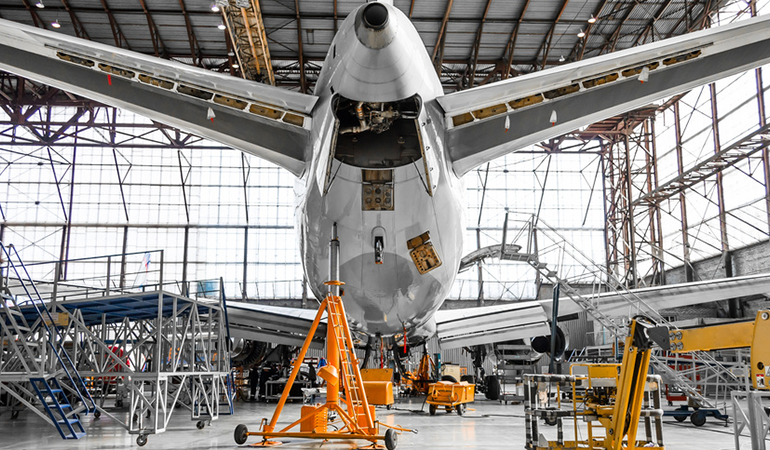What exactly can we do to lower the workload on technicians in the industry? Assume that hiring new personnel for aircraft maintenance is out of the question, then where does that leave the MRO business model? The human component of the technician workforce is not going anywhere any time soon, if ever. So it the question which begs to be asked is where gains in efficiency and accuracy can be achieved. The answer is, as with so many established markets and technical segments, automation and emerging technology.
Historical context of automation in aircraft maintenance
The technical components of aircraft maintenance have traditionally been human-oriented, relying on keen, experienced eyes and human judgment in identifying and analyzing defects. However, technology has never in the past afforded the opportunities which are now available and viable.
Using and applying automation in industrial environments is not a new concept; automobile manufacturers have been using robotics on assembly lines for decades, tracing their roots all the way to 1961 when General Motors used robots for spot welding. Over the ensuing decades, robotic arms would advance and use more autonomy in the assembly process.
Similar principles were available to some extent in aircraft and aerospace manufacturing, and have been used widely in the industry. However, manufacturing and maintenance are two very different concepts. Manufacturing parameters include sterile work environments with virgin materials and very few variables to convolute the process.
If we dig through the engineering archives at NASA, we see that they were pioneering robotics research and engineering to develop an automated tool for cleaning and removing thermal protection material from booster components. This was later adopted by Delta in their MRO facilities in 1992 for cleaning engine components.
Automation in manufacturing versus maintenance
The focus in manufacturing is to produce a symmetrical product efficiently and reduce waste and time over the course of production. It is to produce a new item which exceeds customers expectations and eclipses competitors offerings for a competitive cost.
Maintenance is a different animal than manufacturing. It takes the finished product which has been in operation often for years and thousands of cycles and takes it apart to determine fatigue, failure, and identify areas of deficiency. It takes a keen eye melded with years of experience to identify weaknesses and areas prone to failure. Unfortunately, there is a downside to this: it is not exciting work. It takes a lot of time and experience to become proficient in the art of aircraft structural inspection, but the job is entirely repetitive, which creates an environment ripe for complacency. This is not to insinuate that all shop technicians working inspections docks are complacent; far from it. The environment itself is difficult to prevent complacency because of the monotony.
Automation offers a valuable tool to augment the human component in airframe technical inspections; robotics is not affected by the types of fatigue common to human workers. A robot will inspect identical surfaces indefinitely, looking for any defects or abnormalities in the skin or fasteners and perhaps even be able to do so with sensitivities and tools not possessed by the human eye.
Automated Guided Vehicles (AGV)
AGVs are a great step forward in the hangar where large and heavy components require movement through a maintenance hangar. This includes engine assemblies, wing assemblies, and even full fuselages.
An AGV is built to work in defined areas which can be very space restricted. Since the vehicle must follow a physical boundary (the magnetic tracking line), MROs can establish movement corridors and safety zones for workers and allow the AGVs to move components autonomously, representing huge savings in manpower.
Small UAS (drones)
Small unmanned aircraft systems (SUAS), commonly known as ‘drones’, are finding uses and establishing value far outside of their original purposes. They have tremendous versatility so long as the limitations are understood, but with every advancement in their capability, their envelope of limitations is diminished.
SUAS allow technicians to visually inspect airframe structures which are and difficult to get to otherwise. A drone can be on site inspecting the highest point of the vertical stabilizer in a few seconds, rather than setting up scaffolding or mechanical lifts, and rigging harnesses and safety lines. This isn’t a 100% replacement immediately, but it looks to be being actively adopted in the MRO and manufacturing circles, including by Airbus.
Administrative automation
Perhaps the greatest gains to productivity and efficiency through automation are not to be found in the tool room or the shop floor, but instead will be found in the administrative, culmination of data, and analysis of data. It is hard fact that personnel costs are the largest component of an airline’s budget, with fuel a relatively close second, so it can rationally be established that adding manpower is the least profitable option to productivity. This is not a message to abolish technicians; not at all. Instead, it is streamlining the process by using software solutions to tasks which humans simply cannot do, or using automation to do them much better.
Emerging Technology
Blockchain
Since its inception in 2008 with the development of Bitcoin, cryptocurrency has taken the global economy by storm. While it may perform some portion of the purchasing down the road, the really interesting part of crypto in the aviation industry is the Blockchain technology which is the framework that creates the secure P2P ledger. While the ledger was originally intended for currency, it is infinitely transferable to any operations which require the secure transfer or storage of information.
Aircraft maintenance records are an excellent example of this. These records must be secure from tampering and provide positive accountability of all actors involved, which Blockchain provides by design. Blockchain allows technicians, engineers, and any other parties with a verified need to access records the ability to access and sign maintenance records, as well as move and store archived records.
Internet of Things (IoT)
While it sounds very much like something dreamt up by Robert Heinlein, the Internet of Things is not science fiction, it is a reality. In the simplest terms, it refers to the interrelation and compatibility of machines in an internet atmosphere. In aircraft maintenance, this may take shape as a technician being able to use a mobile device to immediately sync with an airplane upon taxiing into the block to scan for deficiencies. In even very recent years, all records were kept on tape data recorders and had to be run through machines to pull data. IoT changes all of that. Like a very advanced OBDII port on an automobile, IoT could all not only the access of data but an immediate interpretation of it converted to plain language for the technician.
Machine Learning
To non-tech savvy folks, this is confusing; machine learning produces mental images of technicians learning machines. This is not the case at all. Machine learning is “the science of getting computers to act without being explicitly programmed.” To the layperson, this is artificial intelligence at work in a tangible way. It is advanced computer systems using high-end mathematical algorithms to learn and develop things of interest. In the case of an airplane, it would be in conjunction with IoT devices to create useful data, sift through raw data, and produce reliable information for the technical workforce.
The tangible results of using these devices are mapping out the real life cycle of components rather than functioning on generalities. Just like a poker player, aircraft systems have tells when they are failing, sometimes long before catastrophic failure. Machine learning also may help engineers to design sensors which are more reliable or produce more relevant data for the future.
Paperless workforce
While not necessarily a form of automation, or quite as complex as machine learning or IoT, paperless documentation is a huge timesaver in maintenance records. The standard still remains paper records and wet ink signatures which require workers to find the records in question, review, then sign. The technology is here to maintain all records, both current and the historical archives, on a cloud platform which can be accessed via PC or a mobile device. Signatures can be applied by using a secure digital signature, available through dozens of services, or even biometrics since most modern mobile devices contain a biometric scanner. Cumulatively, this would save countless man hours currently being spent in transit to maintenance records, looking through records, correcting records, and signing records. It does not sound like a lot but those small chunks of time add up quickly.
Conclusion to automation in aircraft maintenance
The automated workforce is coming to all sorts of industries, some faster than others. Regulation often keeps aviation from advancing as quickly as other markets, but it is coming. The emerging technologies of Blockchain, machine learning, and IoT are rapidly transforming the world in front of us and the aviation maintenance market is a prime candidate for these forms of automation to be applied. Also, there is ample automated technology out there designed to take some of the physical burdens off of technicians, performing tasks which robotics are often better suited for in the first place. These are not tools to be feared in the industry but embraced because they can streamline processes in a way which humans simply cannot. In the long run, this will only prove to expand capabilities and increase revenues which will promote more work for humans, not less.
You want to stay tuned on trends and innovations in the aviation industry? Subscribe to our blog and don’t miss out on any news!



Comments